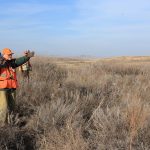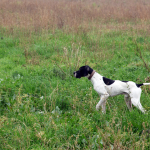The Final Stage
Funny thing happened to me the other day, and oddly enough, it was on a turkey hunt. A turkeyless hunt, actually, as it turned out. I was leaning against a tree, listening to a couple toms gobble at each other a half-mile away and getting no closer, and my son, Chris, my turkey guide and a good one, was off calling to see if he could entice somebody to wander into gun range. Then, not eight feet away, onto the skinny limb of a skinny cherry tree, swooped a merlin – a falcon, also called a pigeon hawk. He looked around at the open field, glanced at the turkey decoys, finally turned all the way around, stared into my soul, and flapped away.
At that very instant, I realized that I had finally reached the fifth and final stage of a hunter – what is called the Sportsman Stage. That’s the stage when the overall experience of being outside with friends and family, or even alone, soaking up what nature offers, and valuing the whole experience is the prime mover for being there, the game bagged and how you did it being little-considered trivialities. I knew that looking back on that hunt maybe a decade from now, I won’t be able to tell you if I got a turkey or not, but I’ll remember that little falcon.
I’m sure you’re familiar with the Five Stages of a Hunter. The first one is the Shooter Stage, when what matters is you get to shoot your gun. A lot. Think in terms of a kid’s first few years.
Next comes the Limiting Out Stage, when we become what are often called “clever collectors,” and the bag is the thing, shooting lots of birds, and we get good at it. To some, a day that’s one duck or pheasant or quail short of the legal limit just isn’t all that satisfying. Unfortunately, a lot of folks never get past this one, especially if they don’t hunt a lot.
Then comes the Trophy Stage. This is a bigger deal to big-game hunters than bird hunters, of course, and entire organizations of big gamers spread their tentacles worldwide in search of trophy beasts of various sizes and shapes. Think deer hunters that won’t shoot anything under an eight-point, or a turkey hunter who wants a 10-inch bearded bird or nothing. For bird hunters, it may be something like shooting every species of grouse in North America, or taking a grand slam of desert quail – Gambel’s, Mearns’, and scalies — on the same day.
Next comes the Method Stage, when how you did it and with what becomes the object – shooting woodcock only over points with an American classic double gun like a Fox or a Parker. Or maybe dropping a rooster pheasant with your granddad’s hammer gun.
That brings us to the final stages, the one I found myself in, the Sportsman Stage, although maybe the “Graduate Stage” would be a better name because we can be a sportsman or woman no matter where we are on this stairway.
That’s not to say that everyone goes through each stage or all of them in this order. And, depending upon what you hunt, you could be in a couple stages at the same time, maybe the Trophy Stage – the woodcock over points thing – but in the Limit Out Stage on pheasants: “I drove all this way to South Dakota and, doggone it, I’m getting my three birds a day.”
I think that for many of us, and certainly for those reading this, the Method Stage and the Sportsman Stage blend and are, at least to me, inseparable. And we know why, don’t we? It’s the dogs. I mean, if using a dog to find birds for us is not a method, I don’t know what is. And that method blends perfectly with the final stage, which is the enjoyment of being out with friends and family, and if you don’t agree that our dogs are both of those then, again, you wouldn’t be reading this magazine. Want to test yourself? Answer me this: If you couldn’t have a dog to hunt with anymore, on a scale of 1 to 5, rate your enthusiasm for the sport.
I thought so. I mean, how many times have we heard and even said that we hunt as much – maybe more – for the dog instead of ourselves. I have climbed out of a warm bed at four a.m. as a November gale howled outside because my Lab wanted to go duck hunting. I have walked into the house exhausted after a day at work to be greeted by my pointers who insisted I take them to a nearby woodcock cover before it gets dark. And I’d do it.
Because of my line of work over four decades as a sporting magazine editor – this one and others – and a half-dozen seasons of a wingshooting TV show, I have been lucky enough (lucky!) to get to a lot of places I’d never go to otherwise. Please, please don’t take this as bragging, but my bucket list has checks next to all the entries because of where I’ve been. And until I wrote that, I hadn’t given any thought to what happens when that happens.
The hunting demographic is aging. And, like a campfire at the end of the evening, the coals still glow, but the flames flicker. For many, the exertion of a hunt is a little too much. For others, lifestyle changes, maybe moves out of state, have drawn our interest away from the field sports. For still others, like me, it’s the whole bucket-list-filled in thing that marks the end of the line.
But even though we may fall into one of those categories, for those of us whose sporting life has been built around our dogs, it seems we keep going. Oh yes, there’s a diminished enthusiasm for getting up at four a.m.; and maybe those two or three away-from-home hunting trips have been pared down in number and/or duration, but some of that fire is still there. I think the best proof of this is that when the dog’s career or life comes to an end, so does the owner’s hunting. I would get letters from fellows who apologized for not renewing their subscriptions because their dog died, they didn’t have it in them to get and train another one, and they gave up hunting. I’d write them back that I completely understood.
At that slowing-down period of a fellow’s hunting life, he doesn’t hunt as hard or maybe as often but he stills wants to work his dog. As you know, dogs think they are forever young, so we have to do their thinking for them, and as they age, we think that they need to take it easier, just like us. So, very often we turn to a shooting preserve for our and our dog’s sport. The bird-finding and shooting are sure things, the walking conditions are a whole lot more user-friendly than an aspen clearcut or waist-high CRP, and you’re not going to be at it all day – a couple hours tops for most hunts. Of course, it costs a bit to do that as opposed to all other hunting, which is free, right? But if so far no one has told you, allow me to be the first: The Baby Boom generation is the one with the money.
All of this is a roundabout way of saying that, yes, we as hunters all go through some or all of these stages, and eventually, our hunting careers wind down and end. But for you and me, that won’t happen until our dogs tell us it’s time. As long as they want to go, so do we.





